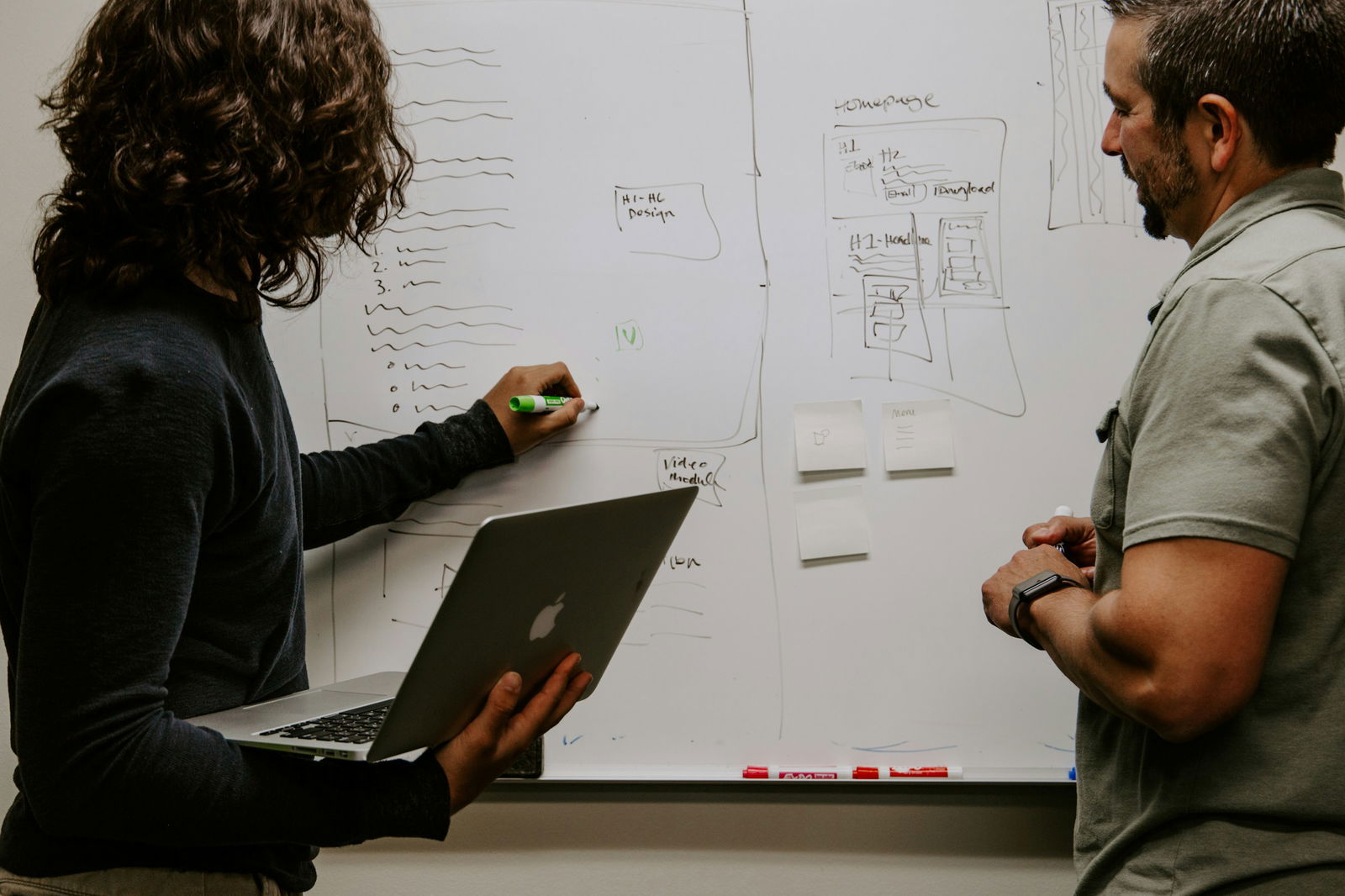Are your landing page call-to-action (CTA) designs not driving conversions as expected? Many face challenges making their CTAs stand out and compel users to take action. We've all been to a number of landing page examples, visiting a landing page and leaving without taking action. The issue might be your CTA design. This article will guide you through improving your CTA design for better conversions.
Do you need help to create compelling CTAs that get visitors to click and convert? Magic UI's startup landing page template can help. Designed to improve CTA design and boost conversions, this tool will transform your landing pages into conversion machines.
What Is CTA Button?

A call-to-action (CTA) button is an interactive UI element on both the web and mobile. Its major aim is to induce people to take specific actions that present a conversion for a particular page or screen, for example:
- Purchase
- Contact
- Subscribe, etc.
The Purpose of a CTA
Lead generation and purchase rise are the primary business goals for which calls to action can be created. When a button design is compelling enough to attract the attention of potential clients immediately, it can entice them to click and proceed to the next stage, such as filling out a short contact form or pre-ordering a product.
Crafting Effective CTAs
There are many factors to consider when you are writing and designing CTAs. Consider the level of buy-in you are asking for from your visitors and tailor it to the page the CTA appears on. For instance, it might be appropriate to put “Request a Quote” on a page about a specific service, but when writing a CTA for your homepage, you may choose something softer like “Learn More.”
Importance of Effective CTA Design in Conversion Rate

Your CTA is the fundamental step that turns visitors into customers; it’s the gatekeeper to the success of your brand. As such, they demand their own design rules. Minor changes have the potential to make a huge impact on conversions, so you must get this one right.
Here are some reasons to have a compelling CTA design:
Drive More Sales
The primary goal of CTA is to drive more sales and fuel business growth. By compelling users to take action and move further down the sales funnel, CTA can help generate:
- Sales
- Leads
- Other valuable conversions
This can drive business success.
Conversion Optimization
Designing a visually appealing call to action button can capture the audience's attention and guide users to a specific action. This can:
- Help improve click rates and conversion rates
- Grab users’ attention
- Enhance your marketing effectiveness
Increase Engagement
CTA can increase engagement on:
- Web page
- Landing page
- Other platforms
They do this by presenting enticing offers, promotions, or incentives. Whether a limited-time offer, a free trial, or exclusive access, a well-designed CTA can encourage users to take action and engage with your brand, thereby increasing conversion rates.
Improve User Experience
CTA directs and provides clear pathways by navigating users to the next step. A well-designed CTA makes it easier for the users to find relevant information with clear content or gives them a sense of urgency to complete the desired actions, resulting in a more positive overall experience.
Designing for Conversion
An effective CTA design is essential for maximizing conversion rates and achieving marketing goals. Craft a design that grabs visitors’ attention and improves their overall experience.
Related Reading
- FAQ Template
- How To Create A Landing Page
- Website Footer
- Website Header Examples
- How To Design A Landing Page
- Creative Landing Page Design
- Pricing Page Examples
- Tailwind Landing Page
- Landing Page UI
- Landing Page Copywriting
7 Crucial Elements of a Compelling CTA Button Design

1. Making Them Stand Out
Placing CTAs in a prominent spot on your webpage is crucial. The CTA should be the first thing viewers see upon entering the webpage. For example, CTAs are commonly placed at the bottom of a popup to catch the user's attention immediately.
2. Usage of Action Keywords
The language in the CTA should direct viewers towards the desired action. By using action keywords like "Sign up now," "Shop now," or "Get Quote," you can guide users to take the necessary steps.
3. Usage of Text in First-person
Crafting the CTA text in the first person can make it sound more personal and informal. For instance, the CTA button for an online reservation app can be designed as "Make my reservation" rather than "Make your reservation."
4. Creation of a Sense of Urgency
Introducing a sense of urgency in your CTA can prompt viewers to act quickly. You can achieve this by including incentives or discounts for a limited time. This sense of urgency can prevent users from procrastinating or forgetting the task.
5. Elimination of Roadblocks
Make the desired action as easy as possible for viewers to complete. Adding another CTA that encourages users to act without friction can be beneficial. For example, if you want viewers to share information with their friends, provide a CTA that streamlines this process.
6. A/B Testing
Conduct A/B testing regularly to enhance the effectiveness of CTAs. You can fine-tune your design by comparing different CTA variations and analyzing their impact on conversion rates. Utilize data and analytical tools to refine your CTAs and achieve better results.
7. Placement
It is vital to strategically position the CTA where users are most likely to see and interact with it. Consider placing the CTA above the fold or experimenting with different locations on your web or landing pages to ensure maximum visibility without requiring excessive scrolling.
Accelerate Your Design Process with MagicUI
MagicUI is a free and open-source UI library designed specifically for design engineers. It provides over 20 animated components built with:
- React
- TypeScript
- Tailwind CSS
- Framer Motion
Try using our startup landing page template today for visually appealing and interactive elements that can be easily integrated into web applications.
Related Reading
- Portfolio Landing Page
- React Portfolio Template
- NextJS Portfolio Template
- React Landing Page
- Startup Landing Page
- Tailwind Portfolio Template
- Best Saas Landing Pages
- React Header
- App Landing Page
- Social Proof On Website
- Hero Section Design
- Waitlist Landing Page
- Best Web Developer Portfolios
- Nextjs Landing Page
21 Best Practices for Designing a Compelling CTA

1. Pick a Primary Call-to-Action
Think about how much we’re able to do on the web:
- Read articles
- Connect to friends
- Buy stuff
- Subscribe
- Watch videos
- Check emails, and so on
This is why so many people suffer from decision fatigue today. It doesn’t just make the decision-maker feel poorly; it can negatively impact the decision-making process.
According to Medical News Today, the psychological effects of decision fatigue can vary, potentially leading to:
- Difficulty making the right decisions
- Impulse buying
- Other avoidance behaviors
As such, a call to action is most effective when it’s the only decision or one of maybe a small handful of decisions you’re asking visitors to make. While each page on your site can offer other links and buttons, you should only have one primary CTA.
2. Keep User Flow in Mind
Big size and bright colors are effective tools for catching users’ attention, but smart placement can increase the chances of CTAs being noticed even more. User flow, also known as user journey, is a path users follow in a digital product to complete a certain task, such as an online purchase. User flow helps to create UX so that people can go step-by-step to their goal and receive the data gradually.
Strategic CTA Placement for Maximum Impact
Keeping the user journey in mind, you can choose efficient placement for CTA buttons. For example, when creating a landing page design, you need to ensure users will find the “Sign up” CTA button after reading the information about the offer or services. This way, users will understand what they are signing up for and whether they need it. If people see such a CTA button before reading the information, they will likely ignore it.
3. Use a Strong, Memorable Color
There was a time when the most significant debate surrounding CTA button design was whether to make them red or green. While color psychology can be useful when designing buttons, it’s not an exact science—especially since the Internet allows even the tiniest of businesses to go global. Colors mean different things to different people and in different cultures, so color psychology isn’t always the best path. Color theory is a more valuable tool.
4. Choose a Simple Serif or Sans Serif Font
You won’t have much room for creativity regarding font choice for buttons. You need visitors to be able to quickly read what’s on them so they can feel confident taking action. As for which web fonts are the most legible, stick to plain-looking serifs and sans serifs with distinctive characters.
5. The Text Should Be Slightly Bigger Than the Surrounding Body Text
Your button design should draw visitors’ eyes to it, not its obnoxiously large size. You still have to consider the size hierarchy when designing CTA buttons. You can use a combination of font size and weight to help direct visitors’ eyes through your content and get them to the CTA much more quickly. It’s up to you how much emphasis you place on your CTA button.
CTA Size and Hierarchy
Primary CTAs should be closer in size to your H1 and H2 than to the body text. Secondary and tertiary CTAs can be smaller if they remain legible and clickable.
6. Increase Button Size for Visibility
The button size can significantly impact the effectiveness of driving user engagement and conversions. By enlarging the size of the call to action button, you make it prominent and easier for users to notice. In addition, it makes it easier for users to interact and creates a bold visual impact.
7. Emphasize Contrast
Emphasizing contrast is important because it helps your buttons stand out from the rest of your website design and content. Your readers won’t click a button they don’t notice.
Making CTAs Stand Out
Use contrasting colors, shapes, sizes, and fonts that differ from your background and other elements on your page. This will naturally draw your visitors’ attention to your buttons and increase conversions.
8. Use Negative Space
Creating negative space (also called white space) around your CTA buttons is important because it helps make them more visible and attractive. Negative space contrasts your buttons and the rest of your page elements, making the buttons stand out and catch your visitors’ eyes.
9. Make Your Vocabulary Dead Clear
Ensure your CTA’s vocabulary is clear and actionable. User attention is precious, so use the momentum to quickly get to the main point with a short but striking copy.
10. Choose Solid Over Outline Button Designs
Giving buttons a transparent outline design becomes trendy every few years or so. These types of buttons are also referred to as “ghost” buttons. The biggest problem with this trend is that research has proven time and time again that outline buttons have lower click-through rates and higher error rates than solid buttons. While they may look more minimal or elegant, they’re not as user-friendly.
Button Styles for Visual Hierarchy
So, when you design your primary CTA buttons, always go for a solid (filled) button design. Then, if you need to add secondary or tertiary buttons to the page, make them ghost buttons to de-emphasize them.
11. Make It Clickable
Visitors must click a button when they see it. So, it has to look clickable when surrounded by non-clickable elements. The simplest way to do this is to give it the rectangular or ovular shape that people have come to associate with buttons. If it fits your branding, you should do more to make your buttons stand out.
12. Add Hover Effects
Adding hover effects can further enhance interaction and draw your audience's attention. To ensure an engaging and interactive user experience:
- Add shadows
- Change the button’s background color
- Increase the size of the buttons
- Add text animation
- Add icons or images.
13. Use Size Differences To Create More Contrast
Using size is an effective way to create a visual hierarchy on the webpage. Make your call to action button design more prominent than other elements on your page. The trick is to use a bigger (or smaller for softer CTAs) button to convey a stark contrast to the rest of the page’s visual elements. That breaks any monotony, which draws attention.
That said, be careful not to make your button too big, as it will become obnoxious. Too small, on the other hand, will make it hard to see or click. Always remember that the goal is to make the CTA button the page's focal point.
14. Use Fewer Words
Less is more for CTA button text. The words “Just Do It” are iconic for a reason. They aren't just simple, powerful, and memorable; they have a visual impact that conveys confidence and authority.
Besides, making users read too much text only adds to their cognitive load as they interact with your webpage. Remember, you have your website visitors’ attention only for a limited time. Don’t ramble, but use action phrases like:
- Buy now
- Book now
- Shop now
15. Add Some Extra Information
It’s essential to keep the CTA message short to catch the attention quickly. However, when the audience notices the call-to-action, it may be helpful to provide additional data. It can be a small piece of information explaining the following stages.
For example, you can clarify that the sign-up process will take less than 15 seconds or remind users that registration is free. A small remark can increase users’ interest and encourage them to take action.
16. Add a Value Proposition
In addition to compelling your readers into a specific action, your text should convey the benefits they’ll receive when they click through. If it isn’t clear what’s in it for them, they have little reason to follow your instructions.
17. Create a Button Design Specifically for Mobile Users
What works well for desktop and laptop users isn’t always the case for smartphone users. And we’re not just talking about the size or color of the CTA button.
18. Mind Your CTA Button Placement
Placement affects how visible and accessible your CTA button is. If the Brafton case study is any indication, placing your CTA button in a prominent and logical position can increase your blog post’s revenue by 83%. Putting your CTA button above the fold (immediately visible without scrolling down the web page) is generally considered the best practice.
CTA Placement
Placement also affects how appealing and persuasive your CTA button is. For example, you’ll never see newsletter sign-up buttons at the top of a blog post. Instead, they’ll be placed at the bottom, so readers get an idea of what kind of content they’ll be signing up for.
Strategic Placement of CTA Buttons on Landing Pages
CTA buttons on most landing pages should come sooner rather than later. Since the point of an effective landing page is for visitors to take action, you don’t want them to waste time searching for the button.
19. Don’t Make Your Buttons Compete for Attention
This best practice has to do with distractions. Or, rather, a lack thereof so that visitors can’t help but be drawn to your CTAs.
20. Use Animations
Animations are trending and a great way to keep a visitor's attention focused on your CTA. For instance, Magic UI's shimmer CTA button is a great way to keep your readers attention on your CTA. Your CTA can easily stand out without competing for attention with the rest of the page copy.
21. Test, Test, Test
Once you’ve created your CTA and implemented all these helpful tips, your job is not over! You need to check that your CTA is having the desired effect. Carry out A/B testing to see how color, message, offer, design, and placement changes affect your conversion rates.
Play around until you’ve found the right combination—sometimes tiny, easy-to-make changes can make a huge difference. And don’t forget to periodically check in to see that the CTA continues to be effective.
Examples of Compelling CTA Design

Infiscal
The CTAs on Infiscal's landing page use simplicity to encourage visitors to take a particular action — a clear and practical approach that can lead to higher conversion rates. Notice the hover effect that makes the CTAs more engaging when visitors hover over the button? You can effortlessly create that and more using Magic UI animated component library.
Contently
These CTAs on Contently’s landing page encourage the audience to "Sign up and request a demo" or "Read a case study," which will be an extended version of the critical numbers mentioned on the landing page. These CTAs are designed with distinct colors to attract customers’ attention.
Jobseeker
This Jobseeker CTA encourages viewers to sign up and create a professional resume. The text showcases a brief outlook on how the resume will be curated using their service. The CTA’s color matches the brand’s and stands out, as everything else is in black.
Spotify
The CTA on Spotify’s app is aimed at audiences who want to sign up and use the app for free. The color green not only stands out in the app but also acts as a motivator and encourages users to sign up.
Dropbox
Dropbox is an online data storage platform for work or personal use. The first CTA encourages the professional audience to sign up for their web app and try it for free. The other asks the user to start their storage facility with Dropbox if they plan to use it for personal use. The CTA is a simple button; the text above gives the visitors relevant details.
Wordstream
This Wordstream CTA persuades viewers to receive a free assessment report to discover how their digital marketing tools suite can help them realize your business objectives. The contrasting color of the CTA makes it stand out from the other elements in the popup.
Common CTA Design Mistakes To Avoid

Overloading Pages With Too Many CTAs
Overloading your landing page with too many CTAs can overwhelm visitors and lead to decision fatigue. Instead, focus on one primary call-to-action button that stands out and guides visitors to the desired action. Keep secondary CTAs to a minimum, providing additional options without distracting from the main objective.
Poor Placement
- Strategically position your CTA to ensure it is easily visible within the layout.
- Avoid burying it in cluttered areas or using the same color scheme and background, as this can make it difficult for visitors to find and engage with.
- Ensure that the CTA pops out and draws attention, prompting visitors to act swiftly.
Neglecting the CTA Copy
Crafting compelling CTA copy is crucial for driving action on your landing page. Avoid generic CTA phrases that don't convey the benefits or urgency of the offer. Tailor your call-to-action content to the customer's sales stage, offering relevant information that entices them to click through. Remember that the CTA copy is the final nudge that convinces visitors to convert—make it count.
Check Out Our React Component Library for Design Engineers
MagicUI is a game-changer in UI libraries, offering over 20 animated components to make your landing pages pop. With MagicUI, you can easily create visually stunning and interactive elements seamlessly integrating into your web applications. The best part? It's free and open-source, allowing you to craft captivating digital experiences effortlessly.
Bridging the Gap Between Design and Development
One of the challenges in creating landing pages is ensuring they are visually appealing and technically sound. MagicUI bridges the gap between design and development by offering highly customizable components that can be adapted to seamlessly match your branding and design requirements. This means you can focus on creating beautiful landing pages without dealing with the technical complexities.
MagicUI Pro: Elevate Your Landing Page Game
With MagicUI Pro, you can take your landing page design to the next level. Using our website templates, you can save thousands of hours and create a beautiful landing page that converts visitors into customers. MagicUI Pro equips you with everything you need to make a stunning startup landing page that captures attention and drives results.
Design Made Easy With MagicUI
The call-to-action (CTA) is one of the most crucial elements of a landing page. With MagicUI, you can effortlessly design compelling CTAs that drive conversions. Our startup landing page template is the perfect starting point for creating a CTA that resonates with your target audience and compels them to act.
Get MagicUI today and see the difference it can make in your landing page design.
